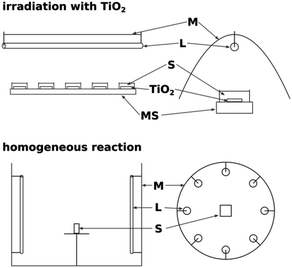Catalytic photodegradation of pharmaceuticals – homogeneous and heterogeneous photocatalysis
S.
Klementova
*a,
D.
Kahoun
a,
L.
Doubkova
a,
K.
Frejlachova
a,
M.
Dusakova
a and
M.
Zlamal
b
aFaculty of Science, University of South Bohemia, Ceske Budejovice, Czech Republic. E-mail: sklement@jcu.cz
bInstitute of Chemical Technology, Prague, Czech Republic
First published on 14th November 2016
Abstract
Photocatalytic degradation of pharmaceuticals (hydrocortisone, estradiol, and verapamil) and personal care product additives (parabens-methyl, ethyl, and propyl derivatives) was investigated in the homogeneous phase (with ferric ions as the catalyst) and on TiO2. Ferric ions in concentrations corresponding to concentrations in natural water bodies were shown to be a significant accelerator of the degradation in homogeneous reaction mixtures. In heterogeneous photocatalytic reactions on TiO2, lower reaction rates, but mineralisation to higher extents, were observed.
Introduction
Pharmaceuticals and personal care products have been distinguished as an emerging class of aquatic contaminants due to their wide and extensive use and eventual entry into sewage waters. Since only partial removal is achieved during sewage water treatment, the pharmaceuticals are likely to constantly enter the aquatic environment.1,2 Some of this family of compounds have been detected in field aquatic samples both in Europe and in the United States.3–5 A large number of non-regulated contaminants have been observed mainly in the ng to μg per litre range in surface waters throughout the UK3,6 and across the rest of Europe.5 To date, more than 200 different pharmaceuticals have been reported in river waters globally.7,8 However, even low concentrations may still pose a threat to aquatic organisms as well as humans in the event of long-term exposure.Runnals et al.9 analyzed a comprehensive UK database covering all prescriptions of pharmaceuticals to determine the annual usage of all steroid and non-steroid pharmaceuticals. They found that compared to estrogens, glucocorticoids are used in much greater amounts.
Processes initiated by light have been demonstrated in many cases to have a strong influence on the environmental fate of xenobiotic compounds. Boreen et al.10 provide a comprehensive review of the photodegradation of pharmaceuticals in the aquatic environment, both in field and laboratory photochemical studies.
Advanced oxidation processes (AOPs) have been investigated for the possible degradation of xenobiotics in natural water bodies. Among AOP techniques, heterogeneous photocatalysis on semiconductors has attracted much attention.11–15
The aim of our study was to determine the kinetics of the photodegradation of several pharmaceuticals and personal care products in two experimental set-ups: in homogeneous aqueous solutions in which the influence of iron as the catalyst was investigated and in a heterogeneous reaction mixture in which immobilised TiO2 was used as the catalyst. The compounds selected for the study are representatives of several groups of widely used pharmaceuticals and personal care products that have been recognised as emerging contaminants: sex steroids, corticosteroids, antiarrhythmic and antihypertension drugs, and conservation agents: hydrocortisone, which is a name of the steroid hormone cortisol when used as a medication (e.g. for skin irritation or allergic reactions); 17β-estradiol, a female sex hormone used to treat the symptoms of menopause, prevention of osteoporosis, and sometimes as a part of cancer treatment in women and men; verapamil, a calcium-channel blocker used to treat high blood pressure and irregular heartbeats and to control angina; and finally, three representatives of parabens i.e. para-hydroxybenzoates (methyl-, ethyl-, and propyl-derivatives) – compounds used as preservatives in pharmaceutical products and cosmetics.
Experimental
The light source Phillips TLD 15 W 08 lamp (light with the wavelength range of 350–410 nm) was used for the irradiation of reaction mixtures with TiO2. TiO2 (Evonik/Degussa Aeroxide P25) was immobilised on soda lime glass. The layer was prepared by placing 0.2 ml of suspension per 1 cm2 so that the final layer contained 0.5 mg of P25 per cm2. After drying under laboratory conditions, the deposited layers were heated to 300 °C for 30 min to achieve a better adhesion of the particulate layer on the glass support. Homogeneous mixtures were irradiated in a Rayonet reactor with RPR 3000 Å lamps (emitted light 254–350 nm); light below 300 nm was filtered out to imitate short-wavelength sun radiation.Radiant flux was measured using a Lutron UV A light meter; the total power of all the electromagnetic radiation within the range of wavelengths 320–390 nm (the range detected by the Lutron meter) emitted per unit time was calculated for the irradiated area; the value for the Rayonet reactor (homogeneous reaction) was 4.5 W, and for the Phillips TLD 15 W 08 lamp, 9.3 W. A schematic diagram of experimental devices is illustrated in Fig. 1.
HPLC was performed on a Thermo Scientific Dionex Ultimate system (USA) with a Phenomenex column Luna 5 μl C18, UV/VIS and fluorescence detectors, DAD 3000RS and FLD 3000RS, resp., isocratic mobile phase methanol/water (65/35) for cortisol, acetonitrile/water (65/35) for parabens, and acetonitrile/water+20 mM KH2PO4 (40/60) for verapamil.
Membrane filters with a pore size of 0.2 μm were used for the filtration of solutions, cellulose acetate filters for verapamil solutions, and nylon filters for the remaining substrates.
Substrate concentrations ranged from 1 × 10−4 to 2 × 10−4 mol l−1 for verapamil, hydrocortisone and parabens; estradiol was prepared as a saturated solution at t = 25 °C.
Total organic carbon (TOC) was analysed as non-purgeable organic carbon by Pt catalytic digestion at 850 °C on an Elementar Vario TOC cube (Germany).
Results and discussion
The photodegradations of verapamil, estradiol, and hydrocortisone in homogeneous solution were shown to depend sharply on ferric ion concentrations in the reaction mixtures. The results are demonstrated in Fig. 2, 3, and 4 for verapamil, estradiol, and hydrocortisone, resp.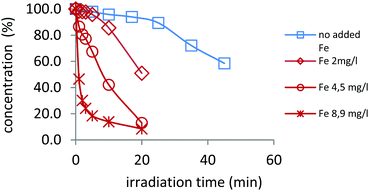 | ||
| Fig. 2 Photodegradation of verapamil in homogeneous solution – dependence on Fe(III) concentration (0, 2, 4.5 and 8.9 mg Fe per l). | ||
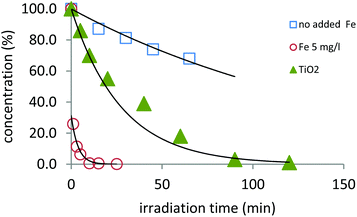 | ||
| Fig. 3 Photodegradation of estradiol in homogeneous solution (dependence on Fe(III) concentration) and on TiO2. | ||
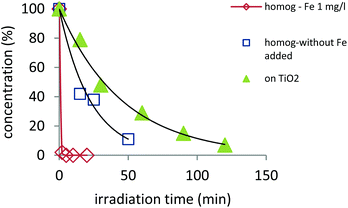 | ||
| Fig. 4 Photodegradation of hydrocortisone in homogeneous solution (dependence on Fe(III) concentration) and on TiO2. | ||
Verapamil without added Fe(III) shows negligible reaction during the first twenty minutes of irradiation (Fig. 2); then, the reaction accelerates – probably due to an autocatalytic mechanism or due to photosensitisation by a reaction intermediate that needs some time to become accumulated in the reaction mixture. A similar pattern can be distinguished if low concentrations of Fe(III) are present. With concentrations higher than 4 mg l−1, the reaction proceeds without such a lag phase. Since in aquatic ecosystems iron concentrations up to several mg l−1 are not unusual,16,17 the phototransformations proceeding as iron-catalysed processes are a possible means of verapamil degradation. Verapamil photochemical degradation in homogeneous solution has not been studied so far. There is, however, a study of combined atmospheric plasma discharge and TiO2 in aqueous solution on verapamil degradation18 and the study by Syam Krishna et al.19 about verapamil degradation in water by gliding arc discharge; a reaction following first order kinetics was observed for the plasma based degradation of verapamil with rate constants of 0.01 min−1 and 0.026 min−1 for the initial concentrations of 5 × 10−4 M and 5 × 10−5 M, resp.
In our study, degradation of verapamil was also investigated in the heterogeneous photochemical reaction on immobilised TiO2. The reaction proceeded as the first order reaction with a reaction rate of 1.9 × 10−2 min−1; after 2 hours of irradiation only about 7% of the verapamil original amount remained in the reaction system. The reaction rate constant is very similar to that reported by Syam Krishna et al.19 in their experiment with gliding arc discharge.
Estradiol exhibits a slow degradation rate (6 × 10−3 min−1) in homogeneous reaction without any Fe(III) added (Fig. 3). Since traces of Fe (2–4 μg l−1) were found in the reaction mixtures, such a degradation may be attributed to the trace amount of iron working as the catalyst. An increased concentration of Fe(III) led to a significant acceleration of the reaction rate (0.336 min−1 for the Fe(III) concentration of 5 mg l−1). The effect of the iron complex with an organic complexation agent on estradiol degradation was studied by Jing Li et al.20 The irradiation experiments were performed in a photoreactor equipped with light bulb lamps (Philips TLD 15 W/05). No reaction was observed without added Fe complex; the addition of Fe complex resulted in an acceleration effect on the estradiol degradation with increasing the Fe concentration up to the value of 2 × 10−4 mol l−1, i.e. 11 mg l−1 Fe. Complete degradation was reached after 400 min of irradiation. Chowdhury et al.21 experimented with a lower Fe concentration added as FeCl3 (in a concentration range of 3 × 10−5–7 × 10−5 mol l−1) and observed a 38% enhancement of the estradiol photodegradation rate due to an increase of Fe3+ concentration in the studied concentration range. The results of both of these studies20,21 have been comparable with degradation kinetics under conditions present in the study in which inorganic Fe in the form of FeCl3 was used as the catalyst. The absence of any reaction without Fe complex added in the study by Jing Li et al.20 seems strange since traces of iron in concentrations of 1–2 μg l−1 that seem to be sufficient for photocatalysed degradation have been found even in ultrapure Milli-Q water.
Degradation of estradiol on TiO2 follows first order kinetics with a rate constant of 3.6 × 10−2 min−1. In 120 minutes of irradiation, all of the substrate has been consumed (Fig. 3).
Hydrocortisone (cortisol) has not been reported to be found in the natural aquatic environment although analyses such as Runnals et al.9 suggest that their discharge into water bodies is probably substantial. The explanation for this may lie in one of the results of the present study: as shown in Fig. 4, the photodegradation of hydrocortisone proceeds quickly (with the rate constant of 4.4 × 10−2 min−1) even if no ferric ions are added into the reaction mixture. Since ICP-MS analysis revealed that iron amounts in the range of 2–4 μg l−1 are present in the reaction mixtures, trace catalysis may be responsible for such a fast photodegradation. In natural water bodies, higher concentrations of iron are available; therefore considerable hydrocortisone degradation is possible. An iron concentration of 1 mg l−1 results in extremely fast degradation – all of the hydrocortisone decayed in less than two minutes after irradiation started.
As shown in Fig. 4, the photocatalysed transformation of hydrocortisone on immobilised TiO2 proceeds with the rate constant of 2.2 × 10−2 min−1. Comparison of the reaction rate in homogeneous (with added Fe) and heterogeneous (on TiO2) reactions can lead to the conclusion that the mechanisms of these reactions are totally different, namely that a degradation of hydrocortisone via hydroxyl radicals oxidation is less effective than the catalytic oxidation with the dissolved oxygen in homogeneous mixtures in which the reduced form of iron acts as a photocatalyst.
Parabens appear to be the most resistant of the studied substrates (Fig. 5). Methylparaben exhibits mild photodegradation only in extremely high concentrations of added Fe (25 mg l−1), which is a value of Fe concentration rarely present in natural water bodies. Ethylparaben and propylparaben are apparently more reactive; 40% and 60% of ethylparaben and propylparben, resp., were degraded after 90 minutes of irradiation in the presence of 5 mg Fe per l in the reaction mixture.
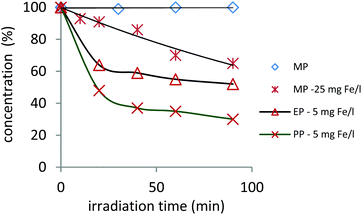 | ||
| Fig. 5 Photodegradation of parabens (dependence on Fe(III) concentration): MP – methylparaben, EP – ethylparaben, PP – propylparaben. | ||
The reaction rate in the initial phase of the reaction can be estimated as 2.2 × 10−1 min−1 and 3.7 × 10−2 min−1 for ethylparaben and propylparaben, resp.
Photocatalytic degradation of methylparaben on TiO2 was studied by Yixin Lin et al.22 in a chemometric multivariable experimental design. They observed that for the methylparaben concentration of 10 mg l−1, 2 g l−1 TiO2, pH = 9, a Philips HPK 125 W mercury high pressure UV lamp with the main emission wavelength mainly around 365 nm, and the reaction mixture oversaturated with O2 (18 mg l−1), the kinetic profile of degradation followed first order kinetics with the rate constant of 1.8 × 10−2 min−1. The degradation observed in our arrangement (Fig. 6) was one order of magnitude lower, with the rate constant of 2 × 10−3 min−1. This difference may have been caused by three contributing factors: O2 supersaturation in the Yixin Lin study, a higher photon flux from the lamp with higher output and an approximately four times higher amount of TiO2 in the irradiated volume in comparison with our study.
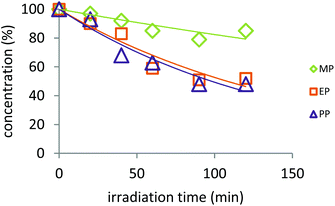 | ||
| Fig. 6 Photochemical degradation of parabens on TiO2. MP – methylparaben, EP – ethylparaben, PP – propylparaben. | ||
Ethylparaben and propylparaben exhibit three times higher degradation rates compared with methylparaben.
In homogeneous reaction mixtures with Fe(III) the reaction mechanism of photochemically induced formation of a catalytically active form is presumed. In the case of Fe, the active form is ferrous ions. The steady state concentration of ferrous ions is affected by the rate of reoxidation, which is influenced by electron transfer between the central ion of the complex and the ligand; this electron transfer is affected by the chemical interaction between Fe and the substrate.23 Steady state Fe(II) concentrations in the studied systems were attained in less than 5 minutes of irradiation; the concentrations of Fe(II) reached values between 60 and 70% of the total added ferric ions.
For total organic carbon (TOC) analyses, reaction mixtures with a similar extent of substrate degradation were used. The results for hydrocortisone, estradiol, and verapamil are summarised in Table 1.
| Sample | Substrate concentration (% of original concentration) | TOC content (% of original amount) |
|---|---|---|
| Hydrocortisone: | ||
| Non-irradiated | 100 | 100 |
| Irradiated without Fe | 10 | 97 |
| Irradiated with Fe | 0 | 97 |
| Irradiated on TiO2 | 6 | 69 |
| Estradiol: | ||
| Non-irradiated | 100 | 100 |
| Irradiated with Fe | 5 | 100 |
| Irradiated on TiO2 | 2 | 68 |
| Verapamil: | ||
| Non-irradiated | 100 | 100 |
| Irradiated with Fe | 13 | 96 |
| Irradiated on TiO2 | 18 | 82 |
The results reveal that photo-initiated degradation in a homogeneous mixture catalysed by Fe(III) does not lead to the mineralisation of the organic substrates to any significant extent. On the other hand, photocatalysed reaction with TiO2 as the catalyst induces mineralisation of 31%, 32%, and 18% of hydrocortisone, estradiol, and verapamil, resp.
Conclusions
Photoinitiated processes involving Fe(III) as a photochemically activated catalyst have been demonstrated to be a feasible mechanism for the degradation of several representative compounds of non-absorbing or slightly absorbing pharmaceuticals of the group of sex steroids (estradiol), corticoids (hydrocortisone), and antiarrhythmic and antihypertension drugs (verapamil). For conservation agents of the paraben group (methyl-, ethyl- and propyl-parabens) used in personal care products, higher levels of Fe ion concentration have been required for degradation, especially for the methyl derivative.Homogeneous photocatalysed processes may represent one of the possible pathways for photochemical degradation of these emerging contaminants in natural waters. In the case of some substrates (such as hydrocortisone), traces of Fe are sufficient for a fast photoinitiated degradation.
Heterogeneous photocatalysis considered as a possible method for wastewater treatment in discharge locations led to lower degradation rates under the experimental design used in the study but obviously exhibits a more favorable extent of mineralisation, which decreases the risk of accumulation of harmful intermediates persisting in the water body.
Acknowledgements
The authors gratefully acknowledge the financial support of the research provided by Faculty of Science, University of South Bohemia. Authors thank Tomas Hubacek and Pavla Fojtikova (both from the Institute of Hydrobiology, Biology Centre CAS) for ICP-MS and TOC measurements. Authors thank David Klement for drawing the diagram in Fig. 1.References
- L. H. M. L. M. Santos, A. N. Araujo, A. Fachini, A. Pena, C. Delerue-Matos and M. C. B. S. M. Montenegro, Ecotoxicological aspects related to the presence of pharmaceuticals in the aquatic environment, J. Hazard. Mater., 2010, 175, 45–95 CrossRef CAS PubMed.
- M. Zupanc, T. Kosjek, M. Petkovsek, M. Dular, B. Kompare, B. Sirok, Z. Blazeka and E. Heath, Removal of pharmaceuticals from wastewater by biological processes, hydrodynamic cavitation and UV treatment, Ultrason. Sonochem., 2013, 20, 1104–1112 CrossRef CAS PubMed.
- D. R. Baker, L. Barron and B. Kasprzyk-Hordern, Illicit and pharmaceutical drug consumption estimated via wastewater analysis. Part A: chemical analysis and drug use estimates, Sci. Total Environ., 2014, 487, 629–641 CrossRef CAS PubMed.
- M. S. Fram and K. Belitz, Occurrence and concentrations of pharmaceutical compounds in groundwater used for public drinking-water supply in California, Sci. Total Environ., 2011, 409, 3409–3417 CrossRef CAS PubMed.
- R. Loos, R. Carvalho, D. C. Antonio, S. Comero, G. Locoro, S. Tavazzi, B. Paracchini, M. Ghiani, T. Lettieri, L. Blaha, B. Jarosova, S. Voorspoels, K. Servaes, P. Haglund, J. Fick, R. H. Lindberg, D. Schwesig and B. M. Gawlik, EU-wide monitoring survey on emerging polar organic contaminants in wastewater treatment plant effluents, Water Res., 2013, 47, 6475–6487 CrossRef CAS PubMed.
- D. R. Baker and B. Kasprzyk-Hordern, Multi-residue analysis of drugs of abuse in wasterwater and surface water by solid-phase extraction an liquid chromatography-positive electrospray ionisation tandem mass spectrometry, J. Chromatogr. A, 2011, 1218, 1620–1631 CrossRef CAS PubMed.
- B. Petrie, R. Barden and B. Kasprzyk-Hordern, A review on emerging contaminants in wastewaters and the environment: Current knowledge, understudied areas and recommendations for future monitoring, Water Res., 2015, 72, 3–27 CrossRef CAS PubMed.
- A. Ismail, A. F. Hazizan, S. Z. Zulkifli and K. Arizono, Determination of 17β-Estradiol Concentration in Aquatic Environment of Peninsular Malaysia using the ELISA Technique, Life Sci. J., 2014, 11, 673–679 CAS.
- T. J. Runnals, L. Margiotta-Casaluci, S. Kugathas and P. Sumpter, Pharmaceuticals in the Aquatic Environment: Steroids and Anti-Steroids as High Priorities for Research, Hum. Ecol. Risk Assess., 2010, 16, 1318–1338 CrossRef.
- A. L. Boreen, W. A. Arnold and K. Mcneill, Photodegradation of Pharmaceuticals in the aquatic environment: A review, Aquat. Sci., 2003, 65, 320–341 CrossRef CAS.
- D. Kenakaraju, B. D. Glass and M. Oelgemöller, Titanium dioxide photocatalysis for pharmaceutical wastewater treatment, Environ. Chem. Lett., 2014, 12, 27–47 CrossRef.
- Yujie He, N. B. Sutton, H. H. H. Rijnaarts and A. A. M. Langenhoff, Degradation of pharmaceuticals in wastewater using immobilized TiO2 photocatalysis under simulated solar irradiation, Appl. Catal., B, 2016, 182, 132–141 CrossRef CAS.
- S. Teixeira, R. Gurke, H. Eckert, K. Kühn, J. Fauler and G. Cuniberti, Photocatalytic degradation of pharmaceuticals present in conventional treated wastewater by nanoparticle suspensions, J. Environ. Chem. Eng., 2016, 4, 287–292 CrossRef CAS.
- S. Sarkar, S. Chakraborty and C. Bhattacharjee, Photocatalytic degradation of pharmaceutical wastes by alginate supported TiO2 nanoparticles in packed bed photo reactor (PBPR), Ecotoxicol. Environ. Saf., 2015, 121, 263–270 CrossRef CAS PubMed.
- Y. X. Lin, C. Ferronato, N. S. Deng and J. M. Chovelon, Study of benzylparaben photocatalytic degradation by TiO2, Appl. Catal., B, 2011, 104, 353–360 CrossRef CAS.
- J. R. Dojlido and G. A. Best, Chemistry of Water and Water Pollution, Ellis Horwood Limited, Chichester, UK, 1993 Search PubMed.
- P. L. Brezonic and W. A. Arnold, Water Chemistry, An Introduction to the Chemistry of Natural and Engineered Aquatic Systems, Oxford University Press, Inc., Oxford, UK, 2011 Search PubMed.
- M. Horakova, S. Klementova, P. Kriz, S. Krishna Balakrishna, P. Spatenka, O. Golovko, P. Hajkova and P. Exnar, The synergistic effect of advanced oxidation processes to eliminate resistant chemical compounds, Surf. Coat. Technol., 2014, 241, 154–158 CrossRef CAS.
- S. Krishna, A. Maslani, T. Izdebski, M. Horakova, S. Klementova and P. Spatenka, Degradation of Verapamil hydrochloride in Water by gliding arc discharge, Chemosphere, 2016, 152, 47–54 CrossRef CAS PubMed.
- J. Li, G. Mailhot, F. Wu and N. Deng, Photochemical efficiency of Fe(iii)-EDDS complex: OH radical production and 17β-estradiol degradation, J. Photochem. Photobiol., A, 2010, 212, 1–7 CrossRef CAS.
- R. R. Chowdhury, P. A. Charpentier and M. B. Ray, Photodegradation of 17beta-estradiol in aquatic solution under solar irradiation: kinetics and influencing water parameters, J. Photochem. Photobiol., A, 2011, 219, 67–75 CrossRef CAS.
- Y. Lin, C. Ferronato, N. Deng, F. Wu and J.-M. Chovelon, Photocatalytic Degradation of Methylparaben by TiO2: Multivariable Experimental Design and Mechanism, Appl. Catal., B, 2009, 88, 32–41 CrossRef CAS.
- S. Klementova and D. M. Wagnerova, Photocatalytic Effect of Fe(III) on Oxidation of Two-Carbon Organic Substances Related to Natural Waters, Collect. Czech. Chem. Commun., 1994, 59, 1066–1076 CrossRef CAS.
| This journal is © The Royal Society of Chemistry and Owner Societies 2017 |

